Introduction to Pediatric Concussion Incidence and Recovery
Pediatric concussions represent a significant public health concern, affecting millions of children annually worldwide. This article explores the epidemiology, incidence rates, recovery timelines, and clinical insights surrounding child concussions. Drawing on extensive scientific research and epidemiological data, we provide a comprehensive overview of concussion occurrence in children, symptom progression, and factors influencing their recovery process. Emphasizing evidence-based approaches, the narrative underscores the complexities of pediatric concussion management and highlights important considerations for healthcare providers, families, and communities.
Incidence Rates and Epidemiology of Child Concussions
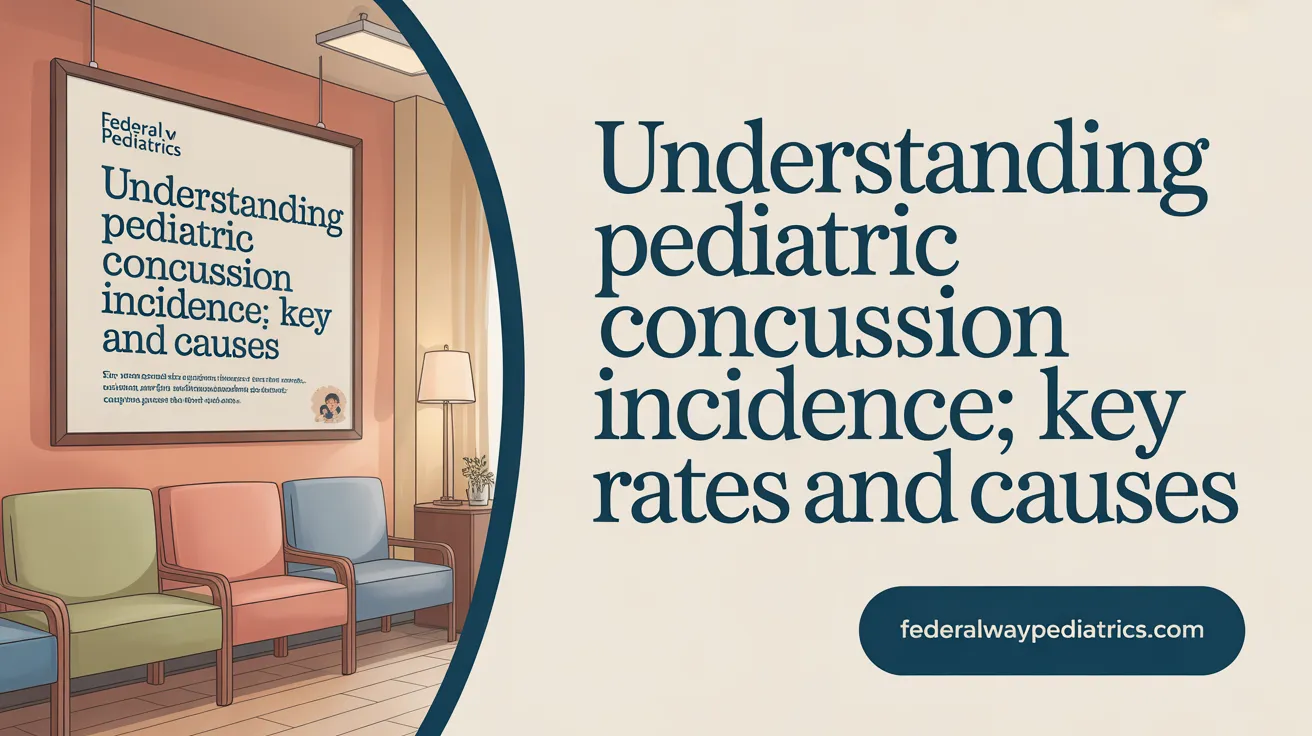
What are the incidence rates of child concussions?
Concussion rates among children can differ based on age and sex, but overall, they are a significant concern for pediatric health. Studies show that approximately 1.1% of children aged 10–11 sustain a concussion each year. This rate increases sharply during adolescence, with about 18.3% of teens aged 13–17 experiencing a concussion annually.
In the United States, concussion-related injuries are common, with about 564,000 children visiting emergency departments for brain injuries each year. Falls are the leading cause of these injuries, especially in preschool children under 5, due to their developing coordination and propensity for accidents.
Boys tend to have higher incidence rates compared to girls, likely reflecting differences in sport participation and injury patterns. Additionally, data indicates that non-Hispanic White children report a higher prevalence of concussions, which may relate to disparities in healthcare access, reporting, or activity levels.
These statistics highlight how widespread brain injuries are among children, making it crucial to focus on prevention, early diagnosis, and appropriate management across pediatric populations.
| Age Group | Approximate Incidence Rate | Leading Causes | Notes |
|---|---|---|---|
| 0-4 years | Higher compared to older children | Falls | Also involves injury from others’ actions in children under 1 |
| 5-12 years | 1.85 per 100 children annually | Falls, sports, physical abuse | Sports participation increases risk |
| 13-19 years | 18.3% in adolescents | Sports collisions, motor vehicle crashes | Peak during mid-adolescence, especially at ages 14-15 |
| Sex Differences | Boys have higher incidence | — | Due to higher engagement in contact sports |
Understanding these patterns helps healthcare providers, parents, and policymakers target interventions effectively, minimizing the risk and impact of concussions in young populations.
Overall Statistics and Prevalence of Pediatric Brain Injuries
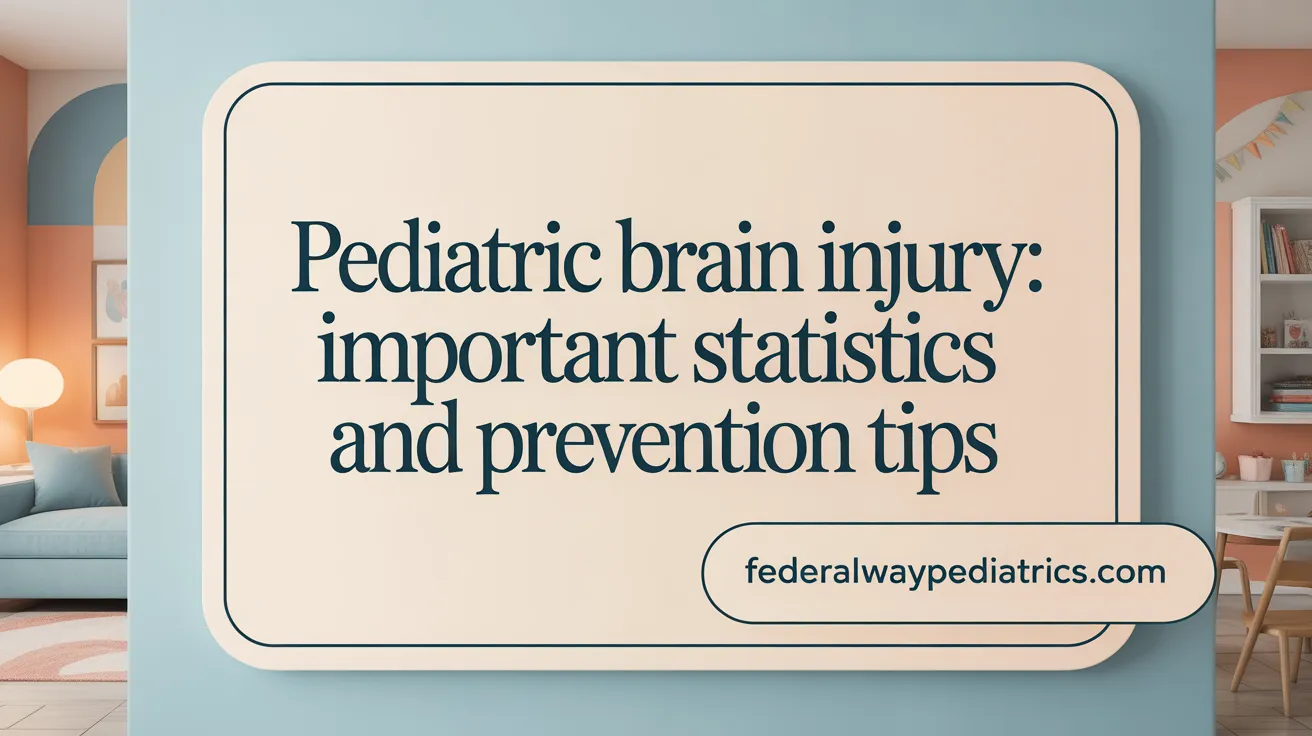 Each year, approximately 62,000 children aged 0-19 in the United States sustain brain injuries severe enough to require hospitalization. An additional 564,000 visit emergency departments for brain injuries and are then released. These numbers highlight the substantial impact of pediatric brain injuries across the country.
Each year, approximately 62,000 children aged 0-19 in the United States sustain brain injuries severe enough to require hospitalization. An additional 564,000 visit emergency departments for brain injuries and are then released. These numbers highlight the substantial impact of pediatric brain injuries across the country.
The age groups most at risk differ depending on the cause. For children aged 0-4, falls stand out as the leading cause of traumatic brain injury (TBI). This is particularly common in preschool children, with the incidence rate at 1.85 per 100 children annually. Children under 1 year are especially vulnerable, often suffering injuries due to caregiver-related accidents.
In children aged 0-14, the annual toll includes approximately 2,685 deaths, 37,000 hospitalizations, and 435,000 emergency visits. Older children and adolescents, especially those aged 14-15 years, face a higher risk of concussion related to sports participation, with an incidence rate of 0.21 per person-year. The risk is particularly high during mid-adolescence.
When examining causes, falls remain the primary mechanism in early childhood, but in older children, motor vehicle crashes, sports injuries, and physical abuse notably contribute to the incidence of brain injuries. Nearly half of all TBI hospitalizations are due to falls, and firearm-related suicides are the leading cause of TBI-related deaths, with over 69,000 deaths reported in 2021.
Overall, pediatric brain injuries predominantly present as mild TBIs, but even these can have long-lasting effects. The importance of preventive measures like safety policies in sports, use of protective gear, and caregiver supervision is emphasized to reduce these injury rates.
| Age Group | Estimated Cases | Main Causes | Severity | Additional Notes |
|---|---|---|---|---|
| 0-4 years | High incidence | Falls | Usually mild, but severe cases occur | Larger head-to-body ratio increases vulnerability |
| 5-14 years | Moderate incidence | Sports, falls | Mild to moderate | Increased participation in contact sports |
| 15-19 years | Elevated incidence | Motor vehicle crashes, sports | Variable | Higher exposure to risk activities |
Understanding these patterns helps target prevention and improve management strategies to safeguard children's health.
Epidemiological Insights into Child Concussion Patterns
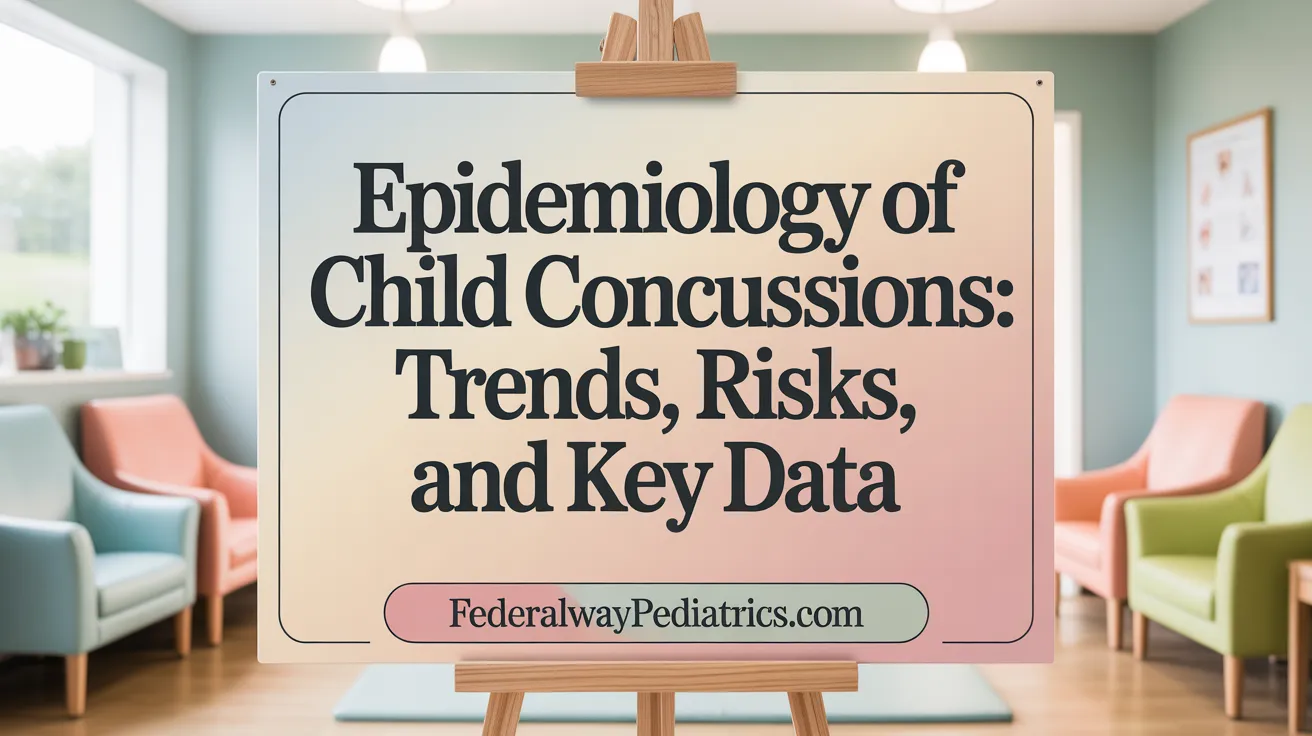
What epidemiological data is available on child concussions?
Research indicates that approximately 6.8% of children aged 17 and under in the United States have experienced concussion symptoms at some point in their lives. This prevalence increases during adolescence, with about 12.2% of 12–17-year-olds reporting past concussions. The data also show that boys and non-Hispanic White children are diagnosed more frequently with concussions than other demographic groups.
Prevalence by age and sex
In early childhood, the incidence of traumatic brain injury (TBI), including concussion, is notably high. Children aged 0-5 experience a TBI rate of 1.85 per 100 children yearly, which surpasses rates in older children. During these early years, falls are the leading cause, especially in children under 1 year, often due to actions by others or environmental hazards.
As children grow older, especially into adolescence, sports-related injuries become more prominent. The incidence of sports-related concussion (SRC) peaks around mid-adolescence, specifically at ages 14–15, with a rate of 0.21 per person-year. Males tend to have higher diagnosis rates, particularly in contact sports, although females often experience different symptom recovery trajectories.
Mechanisms of injury in different age groups
In preschool children, falls account for nearly half of brain injury hospitalizations, with mechanisms frequently involving environmental falls or accidental bumps. Young children often show distinct clinical signs, such as irritability, fussiness, sleep changes, and somatic complaints like stomachaches.
Older children and adolescents are more likely to sustain concussions from sports, transportation accidents, or physical altercations. Contact sports such as rugby, ice hockey, and American football have higher concussion rates, especially during competitive play. These injuries are often associated with impacts that cause a jolting or blow to the head.
Challenges with surveillance and reporting
One of the major hurdles in understanding pediatric concussion epidemiology is inconsistent reporting and diagnostic practices. Many young children with concussion symptoms may go underdiagnosed due to limited age-specific assessment tools and reliance on caregiver reports. This problem is compounded by the overlap of concussion symptoms with other developmental issues, making detection and reporting difficult.
Furthermore, current guidelines for diagnosis and management are primarily tailored for older children and adults, which may result in misclassification or underrecognition in early childhood. These gaps highlight the need for improved surveillance, standardized assessment tools, and age-specific diagnostic criteria.
Differences in symptom presentation in young children
Young children often display different clinical signs of concussion compared to older children. Unlike older kids, who might report headaches or experience loss of consciousness, younger children are more prone to irritability, fussiness, sleep disturbances, and somatic complaints. These symptoms can easily be mistaken for normal developmental behaviors or other illnesses, leading to diagnostic challenges.
Additionally, factors such as their larger head-to-body ratio, weaker neck muscles, and ongoing brain development make young children more vulnerable to severe injuries.
| Aspect | Children 0-4 years | Children 5-12 years | Adolescents 13-17 years |
|---|---|---|---|
| Leading causes | Falls | Sports and falls | Sports, vehicle crashes, Falls |
| Main symptoms | Irritability, sleep issues, somatic complaints | Headaches, balance issues | Headaches, dizziness, concentration problems |
| Diagnostic challenges | Limited assessment tools, caregiver reports | More verbal symptoms available | More accurate symptom reporting, higher detection |
Understanding these distinctions emphasizes the necessity for age-appropriate diagnostic tools and vigilant monitoring to improve concussion detection and management in children of all ages.
Overview of Sport-Related Pediatric Concussions
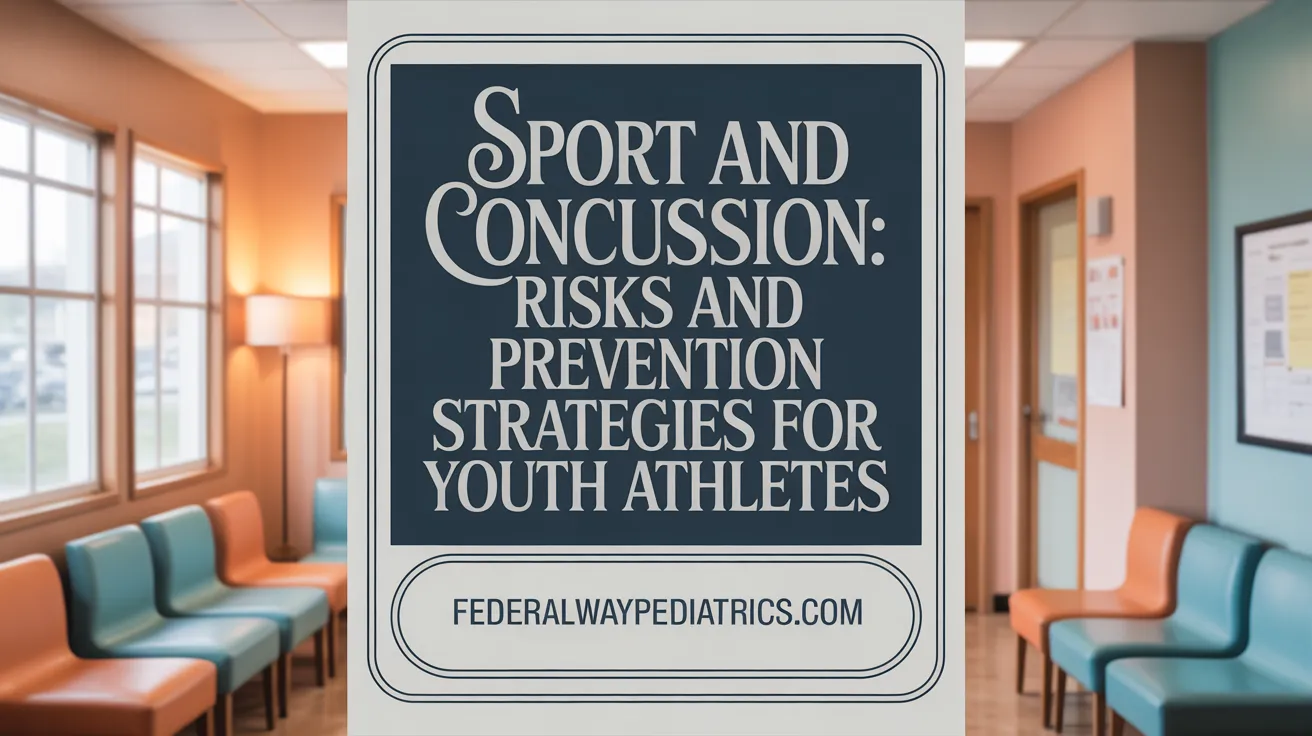
What data pertain to sport-related pediatric concussions?
Sport-related concussions are a prominent concern in pediatric brain injury, especially among youth engaged in organized sports. Research estimates the incidence rate of concussions per 1000 athlete exposures (AE) at approximately 1.41 and per 1000 player hours (PH) at about 4.36. These rates vary across different sports, with collision sports such as rugby, ice hockey, and American football exhibiting significantly higher concussion risks than lower-contact activities.
Participation in collision sports not only elevates the likelihood of sustaining a concussion but also correlates with more severe injury profiles. For instance, the incidence during competitive play is notably higher than during practice sessions.
Gender differences are apparent, with boys generally experiencing higher rates of concussion in youth sports. However, studies indicate that girls may report more severe symptoms and often face longer recovery durations.
Prevention efforts have proven effective. The use of mouthguards, policies banning dangerous practices like bodychecking in youth ice hockey, and neuromuscular training programs in sports like rugby have been associated with reduced concussion incidents.
Diagnosing sport-related concussions has advanced with tools such as the Sport Concussion Assessment Tool (SCAT6 and Child SCAT6), which are most reliable within the first 72 hours post-injury. Post-acute assessment now frequently involves a multimodal approach, including symptom scales, balance, cognitive, vestibular, and mental health evaluations.
Recent updates from the 6th International Consensus Conference on Concussion in Sport recommend a balanced approach emphasizing early recognition, education, and individualized management strategies. Active recovery protocols, including light activity and vestibular rehabilitation, have replaced overly restrictive rest, promoting safer return-to-play timelines.
In summary, understanding the incidence, risk factors, and diagnostic approaches in youth sports is critical for effective prevention and management of concussions, ultimately safeguarding the health of young athletes.
Typical Recovery Timelines for Pediatric Concussion
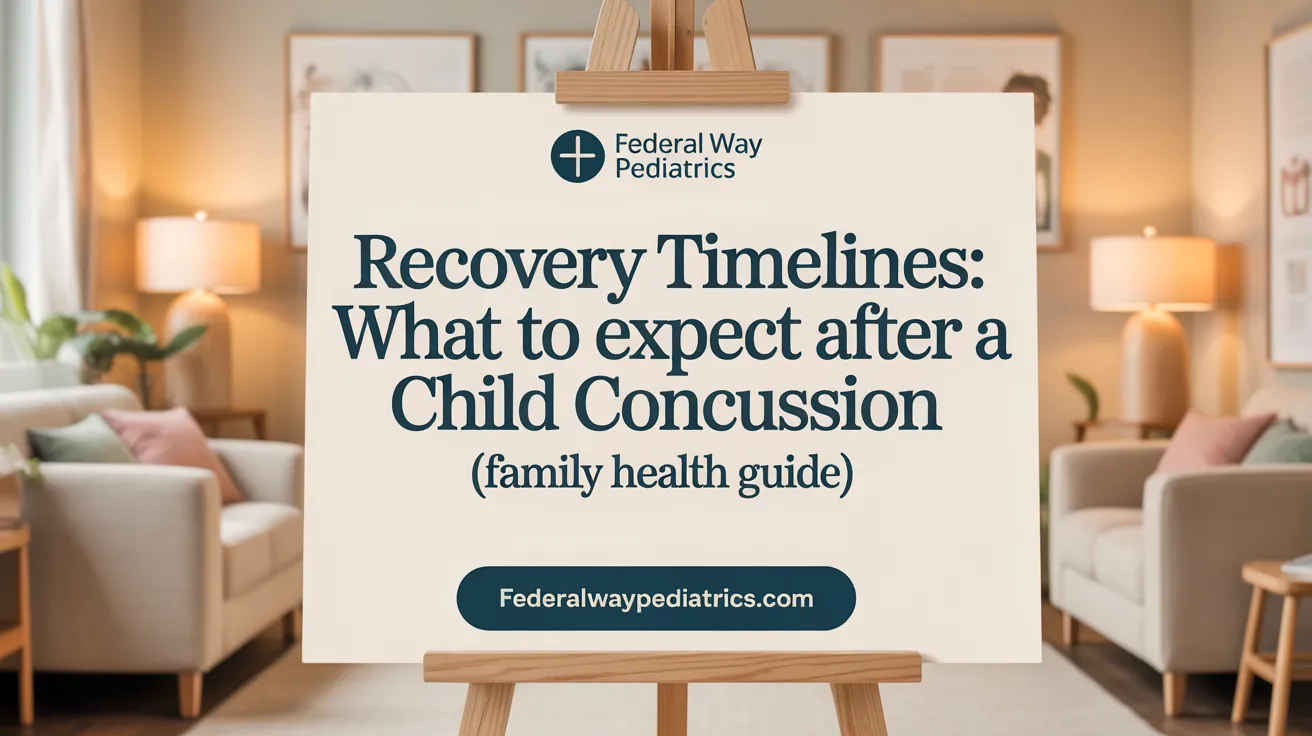
What are the typical recovery timelines for pediatric concussion?
Most children and adolescents with concussion tend to recover within a relatively short period, generally between 1 to 4 weeks after injury. During this initial phase, symptoms such as headache, dizziness, and cognitive difficulties are often most intense.
In the early stages, medical guidelines recommend a gradual resumption of physical activity. Mild activity is usually encouraged within the first 24 to 48 hours post-injury, provided symptoms do not worsen. The goal is to avoid prolonged complete rest, which can delay recovery.
Return to school is typically feasible within about 10 days for most young patients. This timeline allows children to resume academic activities with some accommodations as needed. Similarly, most children can safely return to sports activities within approximately one month, assuming symptom resolution and clearance from healthcare professionals.
Despite these general patterns, a notable proportion—ranging from 14% to nearly 30%—experience persistent symptoms beyond three months. These longer recoveries are more common among children with previous concussion history, females, or those with psychiatric conditions. For them, ongoing management and close monitoring are crucial to address lingering symptoms and prevent complications.
Understanding the variability in recovery timelines emphasizes the importance of individualized assessment, ensuring each child's recovery process aligns with their specific health profile and symptom course.
Symptom Progression and Recovery Patterns in Children with Concussion
What is the typical symptom progression and recovery period for children with concussions?
Children who suffer a concussion usually experience a variety of symptoms that include headaches, dizziness, irritability, sleep disturbances, and sometimes developmental regressions. In very young children, symptoms can differ from older kids—they are less likely to lose consciousness or report headaches but may show signs like being irritable or fussy.
Most children recover within approximately four weeks, with symptoms visibly decreasing in severity. However, the duration varies depending on factors such as age, sex, injury severity, and pre-existing health conditions. Notably, about 30% of pediatric patients continue to experience symptoms beyond this period, often grappling with persistent headaches, cognitive challenges, and emotional issues.
Recovery involves a careful, step-by-step return to normal activities, including school and sports, under medical supervision. This gradual approach minimizes the risk of re-injury and helps ensure the child’s full functional recovery. The initial symptom burden—how severe symptoms are in the days immediately following injury—is a notable predictor of how long recovery may take.
Overall, most children improve within 2 weeks, but longer durations are common, especially among females and those with pre-existing conditions or more severe initial symptoms. Close monitoring and tailored management strategies are critical to support their health and wellbeing during recovery.
Scientific Research Findings on Child Concussion Diagnosis and Outcomes

Imaging findings and limitations
Research on imaging techniques such as MRI and CT scans in children with concussion shows that these tools generally do not reveal consistent or reliable abnormalities predictive of recovery or long-term outcomes. While they are valuable in ruling out other injuries, their sensitivity to concussion-specific brain changes is limited. The subtlety of brain alterations in mild traumatic brain injury (mTBI) means that standard imaging often appears normal, which challenges clinicians to rely on clinical assessments rather than solely imaging results.
Impact on intelligence and cognition
Studies have demonstrated that most children with concussion maintain normal intelligence levels and overall cognitive functioning. Although some children experience symptoms like irritability, sleep disturbances, or developmental regressions, these do not typically translate into measurable declines in IQ or broad cognitive abilities. Nonetheless, in some cases, prolonged symptoms or repeated injuries can contribute to difficulties in attention, processing speed, and other cognitive domains, underscoring the importance of monitoring recovery over time.
Risk of chronic consequences from repeated concussions
Repeated concussions significantly increase the risk of long-term and chronic effects, including chronic traumatic encephalopathy (CTE), a neurodegenerative condition. Children with a history of multiple concussions tend to have a greater headache burden, cognitive impairments, and behavioral issues. Evidence suggests that prior concussion episodes can impair recovery from subsequent injuries and may lead to persistent symptoms lasting months or longer. This highlights the need for careful management and prevention strategies in youth sports.
Emerging diagnostic biomarkers
Current diagnostic approaches rely mainly on symptom reports and clinical assessments. However, researchers are exploring biomarkers such as salivary MicroRNA, blood-based proteins, and Vestibular/Ocular motor screening tools to improve early detection and prognosis of pediatric concussion. These promising biomarkers could offer more objective, rapid, and reliable ways to diagnose concussion and monitor recovery, especially in young children where subjective symptom reporting is challenging.
| Measurement Area | Current Knowledge | Limitations | Future Directions |
|---|---|---|---|
| Imaging (MRI, CT) | Usually normal in mild cases; useful to rule out other injuries | Lack sensitivity for concussion-specific brain changes | Development of advanced imaging techniques |
| Cognitive assessments | Most children retain normal IQ; some experience subtle deficits post-recovery | Variability in recovery; subtle deficits may go unnoticed | Longitudinal studies and sensitive tests |
| Biomarkers (MicroRNA, proteins) | Under investigation; potential for early detection and prognosis | Not yet validated for clinical use | Large-scale studies to establish reliability |
Understanding these findings emphasizes that while current diagnostic tools may have limitations, ongoing research into biomarkers and advanced imaging holds promise for improving pediatric concussion care. Tailored management, early detection, and prevention of recurrent injuries are crucial to safeguarding long-term health outcomes in children.
Evidence-Based Data on Occurrence and Recovery of Child Concussions
What evidence-based information is available on the occurrence and recovery of child concussions?
Concussions among children are a significant global health concern, with approximately 2.7 million affected children worldwide each year. In the United States alone, around 62,000 children aged 0-19 require hospitalization annually due to brain injuries resulting from causes such as falls, motor vehicle crashes, sports injuries, and abuse. Additionally, more than half a million children visit emergency departments each year for these injuries, most of whom are eventually discharged.
The incidence peaks during mid-adolescence (14-15 years), with a rate of approximately 0.21 per person-year, particularly in collision sports like rugby, ice hockey, and American football. Falls remain the leading cause of traumatic brain injury, especially in children under 4 years old.
Recovery from concussion in children generally occurs within about four weeks; most resolve by 4 weeks, though a notable proportion, ranging from 14% to 29%, continue to experience symptoms beyond three months. Factors linked to prolonged recovery include initial symptom severity, gender—females tend to recover more slowly—pre-injury health conditions, and sociodemographic variables such as insurance status.
Tools such as the Sport Concussion Assessment Tools (SCAT6, Child SCAT6) are reliable for diagnosing concussions within the first 72 hours. Digital symptom tracking applications, where adolescents report daily symptoms, reveal that recovery trajectories can vary. Response rates are higher when assessments happen in the evening, and children with previous concussion history often engage more consistently. Early evaluation within 48 hours significantly shortens recovery time, emphasizing the importance of prompt diagnosis and management.
Children with persistent symptoms, including headaches and cognitive impairments, may experience ongoing alterations in brain function, rather than structural damage. These symptoms, along with prolonged recovery, are associated with greater symptom burden early on. Monitoring and addressing these symptoms are critical in guiding safe return to school and sports.
In summary, evidence underscores that early detection, comprehensive assessment, and individualized care are essential components in managing pediatric concussions effectively. Continued research and tailored approaches are needed to reduce the risk of long-term health impacts and support children in returning safely to their daily activities.
Factors Influencing Concussion Recovery in Children
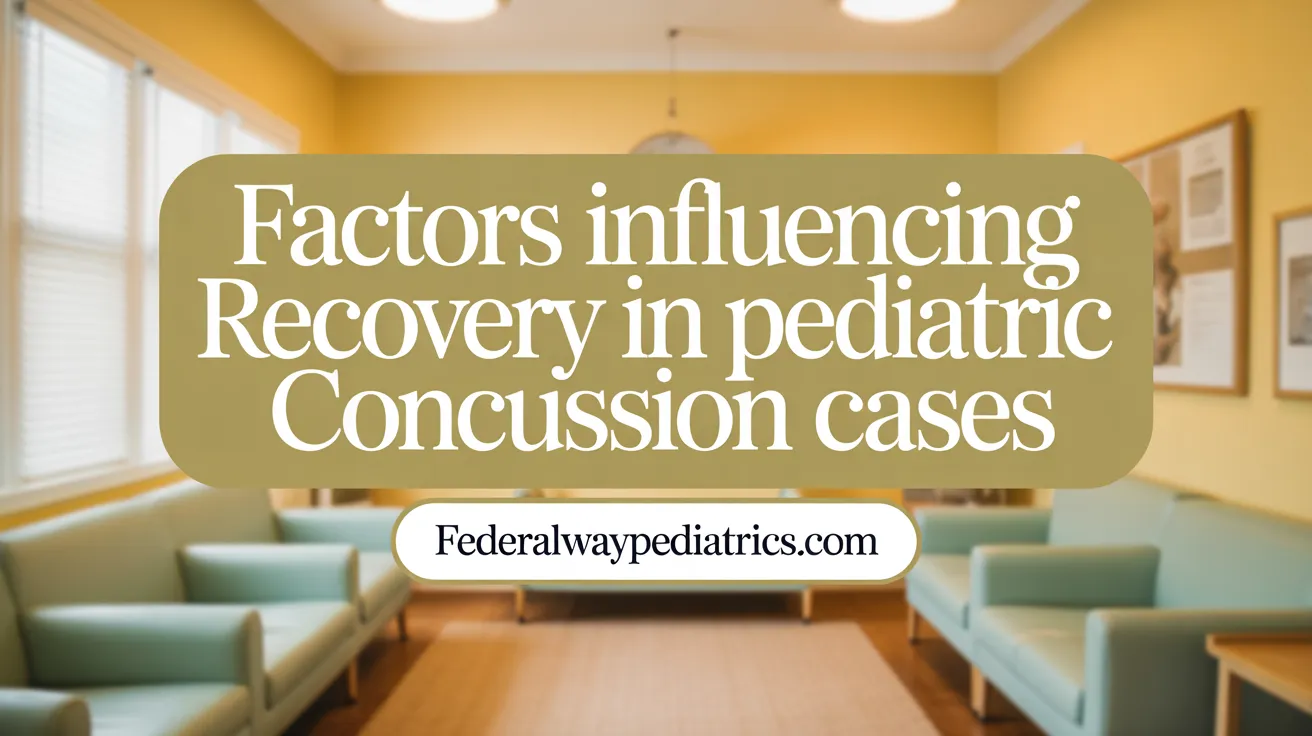
What factors influence concussion recovery in children?
The recovery process after a concussion in children is shaped by several interconnected factors. Age plays a role, with some evidence indicating that younger children, especially those in early childhood, may experience different symptom profiles and recovery patterns compared to older kids and adolescents.
Sex differences are also notable; females often have a slower and more protracted recovery trajectory, particularly early after the injury. This can be attributed to biological differences, hormonal factors, or variations in symptom reporting.
Injury severity, including the initial symptom burden and specific injury mechanisms like sports collisions or motor vehicle crashes, directly impacts how quickly a child recovers. Children with more severe initial symptoms tend to take longer to return to baseline.
Prior concussion history is a significant predictor; children who have experienced previous concussions are at higher risk for longer recovery times and increased symptom burden. Additionally, preexisting health conditions such as migraines, anxiety, or developmental disorders can complicate and prolong recovery.
Sociodemographic variables also influence outcomes. Families' socioeconomic status, insurance coverage, and access to specialized concussion care can either facilitate or hinder recovery. Children from higher-income families with private insurance are more likely to receive prompt and comprehensive care, which can lead to better recovery outcomes.
Environmental and behavioral factors, including the quality of parent–child relationships, mental health status, and environmental stressors, further affect recovery trajectories.
Physical examination findings, such as convergence abnormalities or vestibular issues, have been linked to longer recovery periods, emphasizing the need for comprehensive assessments.
Recognizing these factors highlights the importance of personalized treatment plans, early intervention, and addressing healthcare disparities to promote optimal recovery in pediatric concussion management.
Summary of Current Research on Pediatric Concussion Dynamics
What summarizes current research studies on pediatric concussion?
Recent studies on pediatric concussion reveal a complex picture of recovery that spans multiple domains, including physical, cognitive, socioemotional, and resilience factors. Most children take at least three months to fully return to their pre-injury level of functioning, with recovery trajectories influenced by factors such as sex, comorbid health conditions, and socioeconomic status.
Children with concussion generally experience a gradual improvement over time, with some subgroup variations. Girls, as well as children who sustain more severe symptoms early after injury, tend to have longer recovery periods, sometimes extending beyond six months. This highlights the need for tailored management strategies that consider individual differences.
Diagnosis primarily depends on detailed symptom assessment and medical history, since imaging and biomarkers currently have limited utility in early detection and monitoring. The use of standardized tools like the Sport Concussion Assessment Tools (SCAT6 and Child SCAT6) is recommended within the initial 72 hours after injury, while a multimodal assessment approach is advised for subacute evaluation.
Current guidelines emphasize a cautious, gradual return to physical activity and sports, with the importance of symptom resolution before progression. Despite increasing knowledge, there remains significant research gaps, especially regarding early childhood concussion, where age-specific assessment tools and long-term outcome data are scarce.
Overall, ongoing research continues to refine understanding, aiming to personalize management and improve recovery outcomes for pediatric patients.
Clinical and Epidemiological Insights Informing Pediatric Concussion Recovery
What clinical and epidemiological insights inform child concussion recovery?
Understanding pediatric concussion recovery benefits greatly from recent clinical and epidemiological data. Altogether, these insights emphasize the importance of early diagnosis, personalized symptom management, and diverse rehabilitation strategies.
Children with concussion typically take more than three months to regain full functional health across motor, cognitive, and socioemotional domains. Recovery often depends on factors such as sex, injury mechanism, preinjury health, and sociodemographic variables. Notably, females, children with higher symptom burden early on, or those with certain social disadvantages tend to have longer recovery periods.
Epidemiologically, more than 2.7 million children worldwide experience concussions annually. Falls remain the leading cause, especially in preschool-aged children. Incidents are most frequent during adolescence, peaking at ages 14-15. Sports and activity-related impacts—especially in collision sports—are also significant contributors.
Early diagnosis within 48 hours post-injury correlates with shorter recovery times—about six days less on average—compared to later assessments. Prompt evaluations guide better management, including rest, gradual return to activities, and specialized rehabilitation like vestibular therapy.
Clinical guidelines from international consensus statements recommend cautious return-to-play protocols, emphasizing symptom resolution over a set period. For children, conservative approaches often suggest waiting more than four weeks before returning to sports or school to prevent long-term impairments.
Monitoring symptoms with digital tools such as mobile apps and standardized assessment scales supports accurate tracking of recovery progress. These tools are especially valuable for younger children, who may have communication challenges.
Effective recovery also relies on a multidisciplinary approach. This includes neurologists, physiotherapists, psychologists, teachers, and families working together to tailor interventions. Family involvement, addressing mental health, and accommodating school needs are crucial.
In sum, integrating epidemiological data with clinical best practices enables better management of pediatric concussion. Early diagnosis, supported by technology and multidisciplinary care, optimizes recovery and reduces the risk of chronic issues.
| Aspect | Details | Additional Notes |
|---|---|---|
| Recovery Duration | Usually over 3 months; some persistent symptoms beyond 3 months in up to 29% | Duration influenced by factors like sex, preinjury health |
| Causes | Falls, sports, physical abuse, motor vehicle crashes | Falls most common in under 4s; sports more in teens |
| Early Intervention | Evaluation within 48 hours reduces recovery time | Leads to shorter symptom duration by about 6 days |
| Management Strategies | Rest, gradual activity, vestibular rehab | Use of symptom scales and apps for monitoring |
| Return to Activities | Typically within one month; individualized based on symptom resolution | Supervised by health professionals |
Harnessing this knowledge supports safer, more effective recovery pathways for children and adolescents suffering from concussion.
Relationship Between Concussion Incidence and Recovery Duration in Children
What is the relationship between concussion incidence and recovery duration in children?
Children who have experienced previous concussions are at a higher risk of prolonged recovery and persistent symptoms. Research shows that a history of concussion increases the likelihood of ongoing health issues, including more severe and recurrent headaches. These children often face longer periods before returning to normal activities.
The severity of initial symptoms and injury also play significant roles in determining how long recovery takes. A higher initial symptom burden, such as intense headaches, dizziness, or cognitive impairments shortly after injury, tends to predict a slower and more protracted recovery process.
Sex differences are notable, with females generally exhibiting slower recovery trajectories, especially in cognitive and socioemotional domains. For instance, girls may experience more persistent symptoms and take longer to regain optimal functioning post-injury.
Timely assessment and early access to specialized concussion care are critical. Evaluation within 48 hours of injury is associated with shorter recovery times—approximately 6 days faster on average—compared to evaluations conducted later. Early diagnosis allows for appropriate management, which can include gradual return to activity and targeted therapies.
Demographic and clinical factors such as injury mechanism, socio-economic status, preinjury health, and mental health can influence recovery trajectories. Children from higher-income families often access faster and more comprehensive care, leading to better recovery outcomes.
Overall, the duration of recovery in children is not determined by a single factor but results from a complex interplay of previous injury history, initial injury severity, gender, timing of medical evaluation, and personal and environmental variables. Understanding these relationships helps clinicians develop tailored rehabilitation plans aimed at optimizing recovery and facilitating safe return to school and sports.
Risk Factors, Severity Levels, and Outcomes of Child Concussions
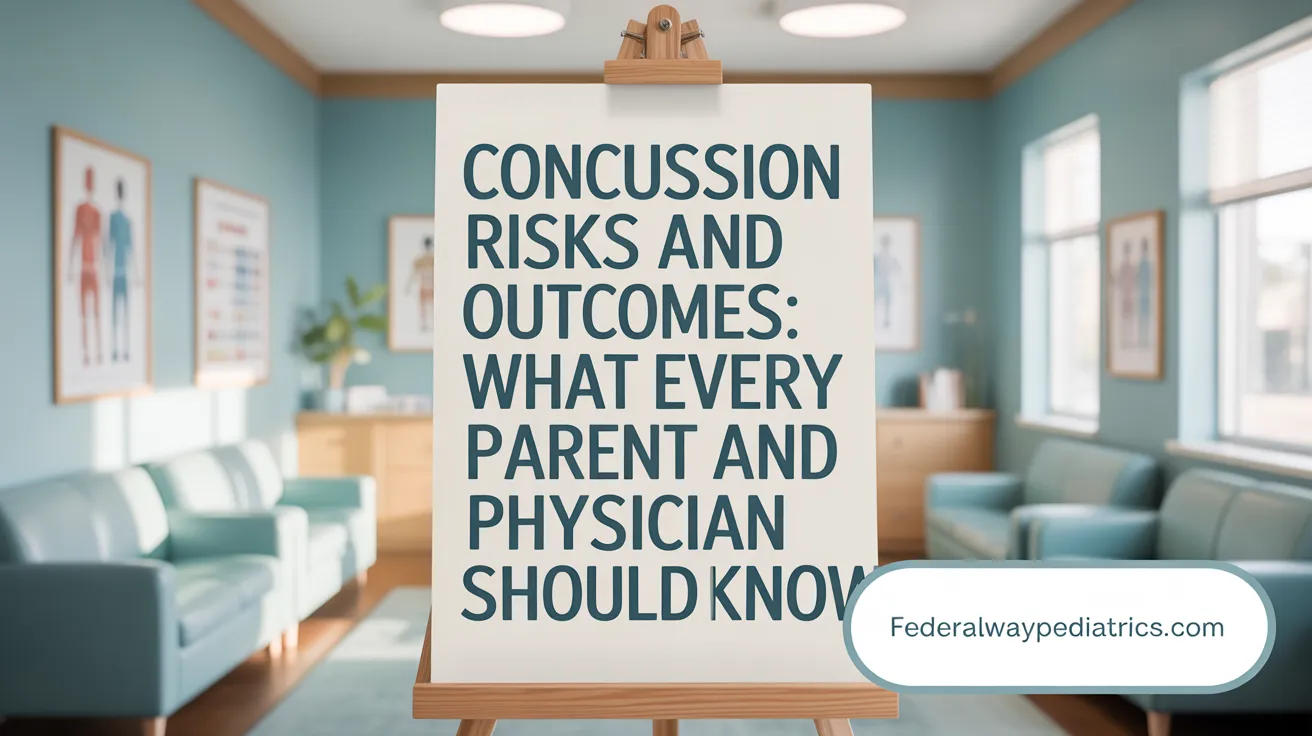
What are the risk factors, severity levels, and recovery outcomes associated with child concussions?
Numerous factors influence the risk and recovery trajectory of pediatric concussions. Younger children, particularly those aged 0-4, are at higher risk of traumatic brain injuries (TBIs), predominantly from falls. In adolescence, the incidence peaks during mid-adolescence (14-15 years), especially among sports participants in collision sports like rugby, ice hockey, and football.
Sex also impacts concussion outcomes. Females tend to have a longer and more protracted recovery, showing fewer instances of optimal functioning early after injury and experiencing more severe symptoms later on. Children with pre-existing health issues such as psychiatric disorders or chronic headaches often face longer recovery periods and may be underdiagnosed due to overlapping symptoms like dizziness or irritability.
Severity can vary considerably, from mild injuries with quick symptom resolution to severe cases requiring extensive management. Most children recover within two weeks, but about 10-14% experience symptoms lasting three months or more, indicating prolonged recovery.
Early intervention is critical. Children evaluated within the first 48 hours after injury tend to recover approximately six days faster than those assessed later. Access to specialized concussion clinics soon after injury significantly reduces recovery time and the risk of persistent symptoms.
Long-term outcomes depend on various factors. Children with multiple prior concussions, especially those involving loss of consciousness, are at increased risk of more severe ongoing issues like chronic headaches and cognitive impairments. Factors such as social environment, school setting, and parental support also influence prognosis.
Understanding these factors helps clinicians develop individualized management plans to mitigate risks, improve recovery speed, and optimize long-term health outcomes for children experiencing concussion.
Incidence and Characteristics of Severe Brain Injuries in Children
Hospitalization and death statistics
Each year in the U.S., approximately 62,000 children aged 0-19 are hospitalized due to brain injuries from various causes such as motor vehicle crashes, falls, sports injuries, and abuse. Additionally, around 564,000 children are treated in emergency departments for brain injuries but are discharged the same day. Tragically, about 2,685 children in this age group die annually, highlighting the serious nature of pediatric brain injuries.
Causes including abuse and motor vehicle crashes
Falls are the leading cause of traumatic brain injury (TBI) in children, especially in those aged 0-4, often due to accidents at home or in daycare. Motor vehicle crashes also significantly contribute to hospitalizations, with physical abuse causing severe or fatal trauma in about 1,300 children each year.
Severity spectrum from mild concussion to severe TBI
Brain injuries in children vary widely, from mild concussions—characterized by symptoms like irritability, sleep issues, and developmental changes—to severe TBI involving loss of consciousness, coma, or death. Studies show that children with concussion need more than three months for full recovery, and some experience persistent symptoms long after the injury.
Population impact and preventive considerations
Kids under 5 are particularly vulnerable, with higher TBI rates than older children, mainly due to falls and accidents involving others. Collision sports such as rugby, football, and hockey carry higher risks, especially during competitions. Implementing safety measures like helmets, concussion protocols, and awareness campaigns are crucial to reduce these injuries. Protecting children through education, safety policies, and early intervention can significantly lower the impact of pediatric TBIs.
Early Childhood Concussions: Unique Vulnerabilities and Clinical Challenges
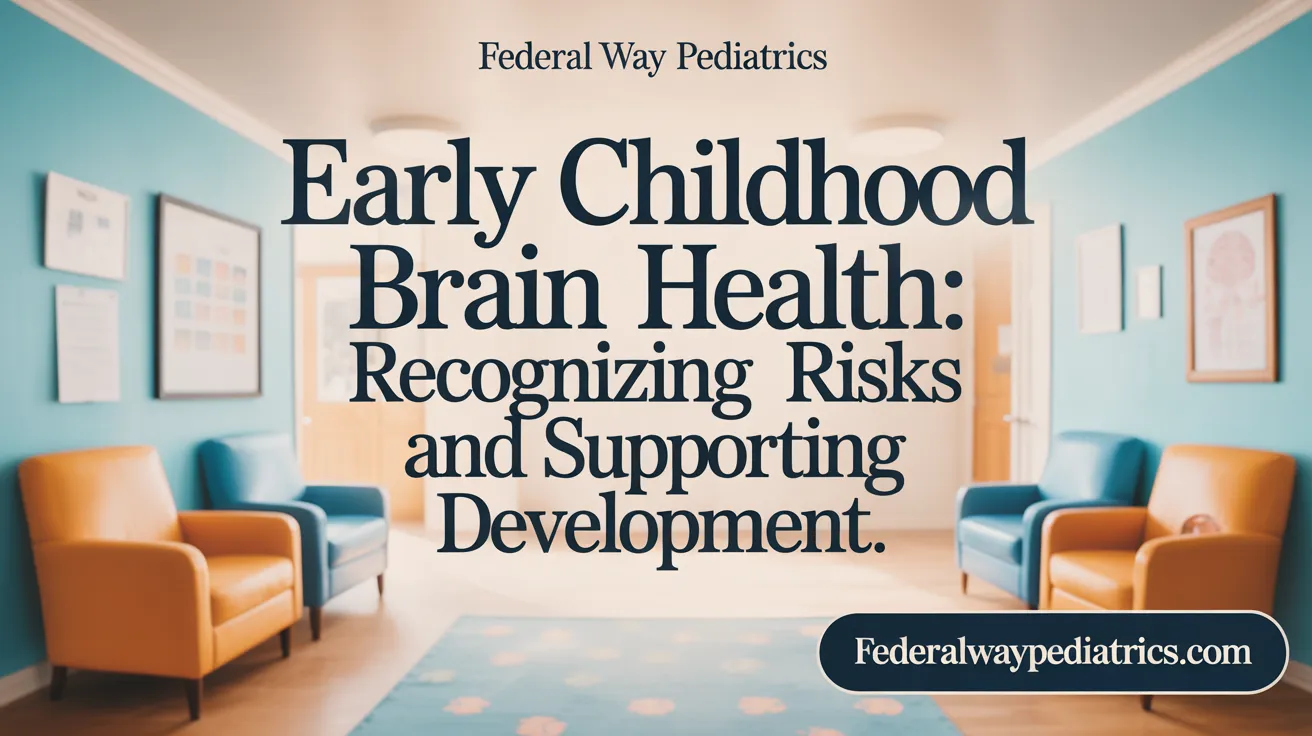
High concussion rates in children aged 0-5
Concussions in early childhood are surprisingly common, with about 1.85 cases per 100 children annually in this age group. Falls are the leading cause of such injuries, typically resulting from activities where young children are being cared for or playing, often involving other individuals. This high incidence underscores the importance of preventive measures and close supervision.
Symptoms distinct from older children
Young children tend to display different clinical signs of concussion compared to older children and adolescents. They are less likely to experience classic symptoms such as headache or loss of consciousness. Instead, behavioral changes such as irritability, fussiness, sleep disturbances, and somatic complaints like stomachaches are more common. Recognizing these subtle cues is critical for early diagnosis.
Influence of developmental anatomy on injury severity
The unique anatomy of young children makes them more susceptible to severe injury. Factors such as a larger head-to-body ratio, weaker neck muscles, and ongoing brain development contribute to increased vulnerability. These features can lead to more severe impacts during falls or blows, often resulting in greater injury severity.
Diagnostic and recovery challenges in this age group
Diagnosing concussion in young children presents significant challenges due to limited age-specific assessment tools and reliance on caregiver reports. Symptoms are often subtle or atypical, making clinical judgment complex. Recovery trajectories also differ, with many children taking more than three months to fully recover across physical, cognitive, and socioemotional domains.
Understanding these distinctive aspects of concussion in early childhood emphasizes the need for tailored diagnostic criteria, sensitive assessment tools, and comprehensive management strategies to address their unique vulnerabilities and improve recovery outcomes.
Engagement and Symptom Monitoring in Pediatric Concussion Research
Use of mobile apps for daily symptom tracking
Recent studies have explored the role of mobile apps in monitoring symptoms of pediatric concussion. Adolescents with concussion frequently report their symptoms using these apps over several weeks, providing real-time data that can enhance understanding of recovery patterns. In one study involving 56 youth aged 11-18, participants used a mobile app to record their daily symptoms for four weeks.
Variations in response rates by time of day and patient demographics
Response rates varied notably throughout the day. Evening responses had the highest median rate at 37%, compared to 21% in the morning and 26% in the afternoon. Factors such as female sex, longer duration since injury, and prior concussion history were associated with higher response engagement. These variations emphasize the importance of timing in symptom monitoring and suggest that evening assessments may be more reliable.
Implications for clinical assessment and research validity
The ability to collect consistent symptom data remotely offers significant benefits for both clinical care and research. It enables more accurate tracking of symptom progression and recovery, especially when traditional clinic visits are limited. However, response variability based on demographic factors and time of day must be considered to ensure data validity. Tailoring app engagement strategies can improve participation and the reliability of symptom monitoring, ultimately leading to better-informed treatment decisions.
Impact of Insurance Status and Socioeconomic Factors on Recovery
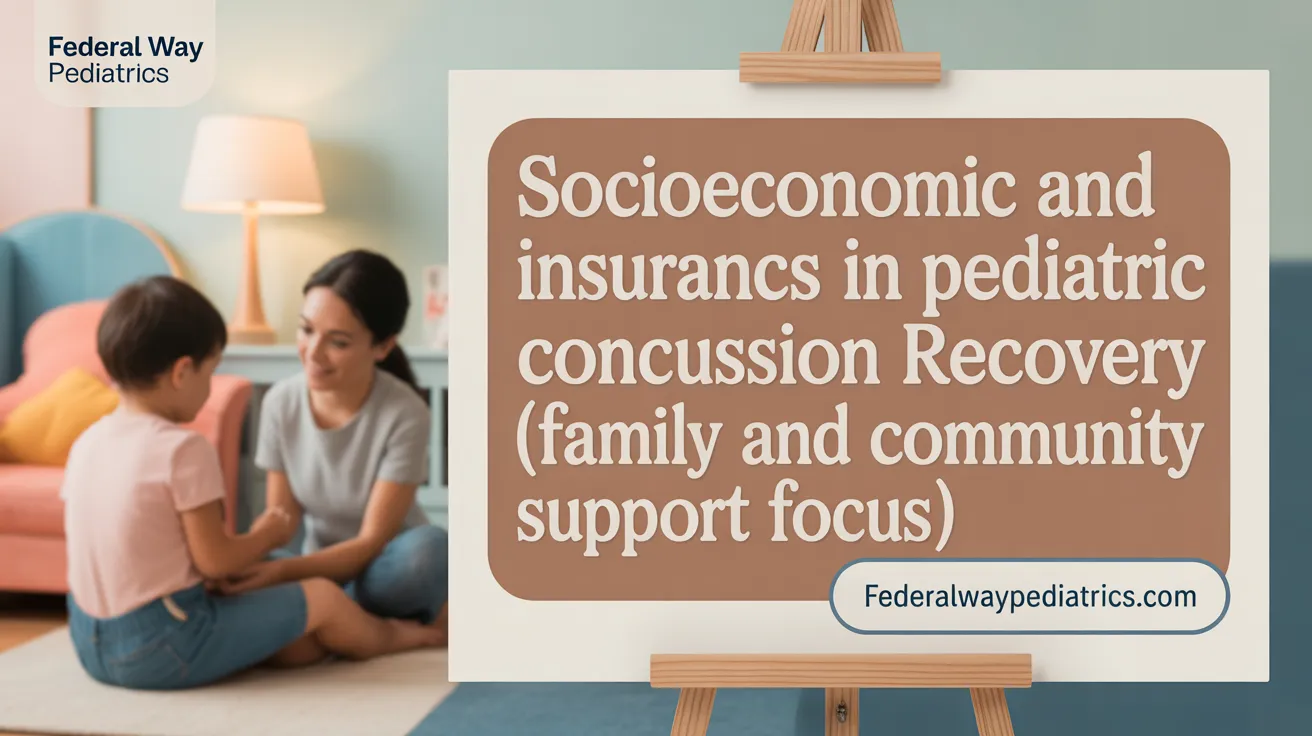
How does insurance status influence access to specialized concussion care?
Children with private insurance generally have better access to specialized concussion clinics and treatments. This advantage allows for quicker diagnosis, personalized management plans, and timely rehabilitation, which can speed up recovery.
Conversely, children covered by public insurance or without insurance often face barriers like limited provider availability and longer wait times. These disparities can delay crucial care, potentially prolong recovery and increase the risk of persistent symptoms.
What is the association between socioeconomic status and recovery speed?
Socioeconomic factors such as family income, parental education, and neighborhood resources significantly impact recovery trajectories. Higher income and better resources typically facilitate access to comprehensive care and healthier environments, supporting faster recovery.
Children from lower-income families may experience longer recovery periods due to challenges in accessing specialty healthcare, follow-up appointments, and appropriate rehabilitation services.
What barriers do children in public schools and low-income families face?
Children in public schools and low-income families often encounter obstacles such as transportation difficulties, insufficient health literacy, and limited liaisons with healthcare providers. These barriers can delay diagnosis and treatment, lead to inconsistent follow-up, and hinder adherence to recovery protocols.
Addressing these disparities requires concerted efforts, including policy initiatives to expand coverage, community outreach programs, and school-based health services that provide equitable concussion management.
| Aspect | Disparity | Impact | Additional Notes |
|---|---|---|---|
| Access to care | Less access for children with public insurance | Longer wait times, delayed diagnosis | Ensuring equitable access improves outcomes |
| Recovery speed | Socioeconomic status influences recovery time | Lower SES linked to prolonged symptoms | Support systems are critical |
| Barriers | Transportation, health literacy, follow-up adherence | Increased risk of ongoing symptoms | Community and school interventions can help |
Understanding these socioeconomic influences is essential for developing effective strategies to ensure all children receive adequate concussion care, regardless of their background.
Prevention Strategies and Guidelines for Pediatric Sport-Related Concussion
How effective are mouthguards and policy changes in preventing sports-related concussions?
Mouthguards are widely recommended for reducing oral injuries, but their role in preventing concussions remains less clear. However, some studies suggest that proper mouthguard use can slightly lower the risk of brain injuries. Policy shifts, such as banning bodychecking in youth ice hockey, have been more impactful in reducing concussion rates.
What benefits does neuromuscular training offer to youth athletes?
Neuromuscular training focuses on enhancing balance, coordination, and muscle strength. Implementing these programs in sports like rugby has been linked to decreased concussion incidence. These strategies help athletes better control their movements, potentially reducing the severity or likelihood of head impacts.
What is the current consensus on return-to-sport protocols for children?
Updated guidelines, such as those from the 6th International Consensus Conference on Concussion in Sport (2022), emphasize a cautious, step-wise approach. Children should remain symptom-free and gradually increase activity levels under professional supervision. Recovery time typically exceeds that for adults, often requiring more than four weeks of rest before full return.
| Prevention Measure | Evidence of Effectiveness | Notes |
|---|---|---|
| Mouthguards | Moderate, some reduction in concussion risk | Proper fit is essential. Not solely protective against concussion. |
| Policy changes (e.g., banning bodychecking) | Significant decrease in concussion incidence | Particularly effective in organized youth sports. |
| Neuromuscular training | Reduces concussion occurrence | Best when incorporated before the season starts. |
| Return-to-sport protocols | Ensures safe recovery before resuming activity | Based on symptom resolution and physical assessment. |
Diagnostic and Rehabilitation Tools in Pediatric Concussion Management
What is the role of SCAT6 and Child SCAT6 in early diagnosis?
The Sport Concussion Assessment Tools—SCAT6 for older children and adults, and the Child SCAT6 specifically designed for younger patients—are valuable in diagnosing sport-related concussions within the first 72 hours post-injury. These tools help clinicians evaluate symptom severity, balance, cognitive functions, and oculomotor responses. Their reliability declines after the initial week, emphasizing the importance of prompt assessment. Early diagnosis using these standardized tools can guide effective management and recovery planning.
What is the value of multimodal assessment for subacute evaluations?
Beyond initial testing, subacute evaluations—conducted more than three days after injury—require a comprehensive, multimodal approach. This involves assessing symptoms using scales, along with balance tests, cognitive assessments, oculomotor examinations, and mental health evaluations. Techniques like the SCOAT6 and Child SCOAT6 integrate these domains to better understand ongoing issues and tailor interventions. This layered assessment improves accuracy in guiding recovery decisions, especially since many children experience persistent symptoms even after the typical 4-week recovery window.
What are some emerging rehabilitation practices and where are the gaps?
Rehabilitation strategies such as cervicovestibular therapy and active rehab protocols are recommended for children with symptoms like dizziness, neck pain, or headaches lasting over 10 days. These practices aim to restore normal function and reduce symptom duration. However, research on their effectiveness in children aged 5-12 remains limited, highlighting gaps in current evidence. Further large-scale, longitudinal studies are needed to establish evidence-based guidelines and optimize recovery approaches for the pediatric population.
Concluding Insights on Pediatric Concussion Incidence and Recovery
Child concussions remain a prevalent injury with complex epidemiological patterns and recovery trajectories influenced by myriad factors including age, sex, injury mechanism, and access to care. Most pediatric patients experience symptom resolution within one month; however, a significant minority face prolonged recovery requiring specialized intervention. Advances in diagnostic tools, digital symptom monitoring, and rehabilitation strategies offer promising avenues to enhance outcomes. Importantly, prevention through education, policy, and protective equipment remains foundational. Future research must continue addressing gaps, particularly in early childhood concussion understanding and management, to foster improved care and long-term wellbeing for affected children.
References
- Incidence - Brain Injury Association of America
- Optimal Recovery Following Pediatric Concussion - JAMA Network
- Early Childhood Concussion | American Academy of Pediatrics
- Facts About TBI | Traumatic Brain Injury & Concussion - CDC
- Response Rate Patterns in Adolescents With Concussion Using ...
- Socioeconomic and demographic considerations of pediatric ...
- Evaluation of differences across age groups in the incidence ...
- Association between days for concussion recovery and initial ...
- The Incidence of Sports-Related Concussion in Children and ...
